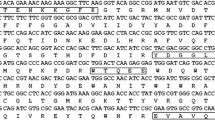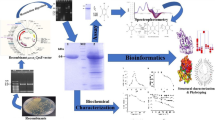Abstract
A new member of class IV of cytochrome P450 monooxygenases was identified in Rhodococcus ruber strain DSM 44319. As the genome of R. ruber has not been sequenced, a P450-like gene fragment was amplified using degenerated primers. The flanking regions of the P450-like DNA fragment were identified by directional genome walking using polymerase chain reaction. The primary protein structure suggests a natural self-sufficient fusion protein consisting of ferredoxin, flavin-containing reductase, and P450 monooxygenase. The only flavin found within the enzyme was riboflavin 5′-monophosphate. The enzyme was successfully expressed in Escherichia coli, purified and characterized. In the presence of NADPH, the P450 monooxygenase showed hydroxylation activity towards polycyclic aromatic hydrocarbons naphthalene, indene, acenaphthene, toluene, fluorene, m-xylene, and ethyl benzene. The conversion of naphthalene, acenaphthene, and fluorene resulted in respective ring monohydroxylated metabolites. Alkyl aromatics like toluene, m-xylene, and ethyl benzene were hydroxylated exclusively at the side chains. The new enzyme’s ability to oxidize such compounds makes it a potential candidate for biodegradation of pollutants and an attractive biocatalyst for synthesis.


Similar content being viewed by others
References
Altschul SF (1991) Amino acid substitution matrices from an information theoretic perspective. J Mol Biol 219:555–565
Bornscheuer UT (2002) Methods to increase enantioselectivity of lipases and esterases. Curr Opin Biotechnol 13:543–547
Bornscheuer UT, Pohl M (2001) Improved biocatalysts by directed evolution and rational protein design. Curr Opin Chem Biol 5:137–143
Cryle MJ, Stok JE, De Voss JJ (2003) Reactions catalyzed by bacterial cytochromes P450. Aust J Chem 56:749–762
De Mot R, Parret AH (2002) A novel class of self-sufficient cytochrome P450 monooxygenases in prokaryotes. Trends Microbiol 10:502–508
Farinas ET, Bulter T, Arnold FH (2001) Directed enzyme evolution. Curr Opin Biotechnol 12:545–551
Finnerty WR (1992) The biology and genetics of the genus Rhodococcus. Annu Rev Microbiol 46:193–218
Fruetel JA, Mackman RL, Peterson JA, Ortiz de Montellano PR (1994) Relationship of active site topology to substrate specificity for cytochrome P450terp (CYP108). J Biol Chem 269:28815–28821
Gliszczynska A, Koziolowa A (1998) Chromatographic determination of flavin derivatives in baker’s yeast. J Chromatogr A 822:59–66
Gustafsson MC, Roitel O, Marshall KR, Noble MA, Chapman SK, Pessegueiro A, Fulco AJ, Cheesman MR, von Wachenfeldt C, Munro AW (2004) Expression, purification, and characterization of Bacillus subtilis cytochromes P450 CYP102A2 and CYP102A3: flavocytochrome homologues of P450 BM3 from Bacillus megaterium. Biochemistry 43:5474–5487
Harford-Cross CF, Carmichael AB, Allan FK, England PA, Rouch DA, Wong LL (2000) Protein engineering of cytochrome P450(cam) (CYP101) for the oxidation of polycyclic aromatic hydrocarbons. Protein Eng 13:121–128
Hedegaard J, Gunsalus IC (1965) Mixed function oxidation. IV. An induced methylene hydroxylase in camphor oxidation. J Biol Chem 240:4038–4043
Li QS, Ogawa J, Schmid RD, Shimizu S (2001) Engineering cytochrome P450 BM-3 for oxidation of polycyclic aromatic hydrocarbons. Appl Environ Microbiol 67:5735–5739
Mansuy D (1994) Cytochromes P-450 and model systems—great diversity of catalyzed-reactions. Pure Appl Chem 66:737–744
Mishra RN, Singla-Pareek SL, Nair S, Sopory SK, Reddy MK (2002) Directional genome walking using PCR. Biotechniques 33:830–832, 834
Nagy I, Schoofs G, Compernolle F, Proost P, Vanderleyden J, de Mot R (1995) Degradation of the thiocarbamate herbicide EPTC (S-ethyl dipropylcarbamothioate) and biosafening by Rhodococcus sp. strain NI86/21 involve an inducible cytochrome P-450 system and aldehyde dehydrogenase. J Bacteriol 177:676–687
Nakayama N, Takemae A, Shoun H (1996) Cytochrome P450foxy, a catalytically self-sufficient fatty acid hydroxylase of the fungus Fusarium oxysporum. J Biochem (Tokyo) 119:435–440
Narhi LO, Fulco AJ (1986) Characterization of a catalytically self-sufficient 119,000-dalton cytochrome P450 monooxygenase induced by barbiturates in Bacillus megaterium. J Biol Chem 261:7160–7169
Omura T, Sato R (1964) The carbon monoxide-binding pigment of liver microsomes. I. Evidence for its hemoprotein nature. J Biol Chem 239:2370–2378
Roberts GA, Grogan G, Greter A, Flitsch SL, Turner NJ (2002) Identification of a new class of cytochrome P450 from a Rhodococcus sp. J Bacteriol 184:3898–3908
Roberts GA, Celik A, Hunter DJ, Ost TW, White JH, Chapman SK, Turner NJ, Flitsch SL (2003) A self-sufficient cytochrome P450 with a primary structural organization that includes a flavin domain and a [2Fe–2S] redox center. J Biol Chem 278:48914–48920
Ropp JD, Gunsalus IC, Sligar SG (1993) Cloning and expression of a member of a new cytochrome P450 family: cytochrome P-450lin (CYP111) from Pseudomonas incognita. J Bacteriol 175:6028–6037
Sambrook J, Russell DW (2000) Molecular cloning, 3rd edn. Cold Spring Harbor Laboratory, New York
Schmid A, Dordick JS, Hauer B, Kiener A, Wubbolts M, Witholt B (2001) Industrial biocatalysis today and tomorrow. Nature 409:258–268
Seng Wong T, Arnold FH, Schwaneberg U (2004) Laboratory evolution of cytochrome P450 BM-3 monooxygenase for organic cosolvents. Biotechnol Bioeng 85:351–358
Shuttleworth KL, Cerniglia CE (1995) Environmental aspects of PAH biodegradation. Appl Biochem Biotechnol 54:291–302
Tyson CA, Lipscomb JD, Gunsalus IC (1972) The role of putidaredoxin and P450 cam in methylene hydroxylation. J Biol Chem 247:5777–5784
van Beilen JB, Wubbolts MG, Witholt B (1994) Genetics of alkane oxidation by Pseudomonas oleovorans. Biodegradation 5:161–174
Werck-Reichhart D, Feyereisen R (2000) Cytochromes P450: a success story. Genome Biol 1:REVIEWS3003
Acknowledgements
We thank S. Maurer and M. Budde for useful discussions.
Author information
Authors and Affiliations
Corresponding author
Rights and permissions
About this article
Cite this article
Liu, L., Schmid, R.D. & Urlacher, V.B. Cloning, expression, and characterization of a self-sufficient cytochrome P450 monooxygenase from Rhodococcus ruber DSM 44319. Appl Microbiol Biotechnol 72, 876–882 (2006). https://doi.org/10.1007/s00253-006-0355-0
Received:
Revised:
Accepted:
Published:
Issue Date:
DOI: https://doi.org/10.1007/s00253-006-0355-0




